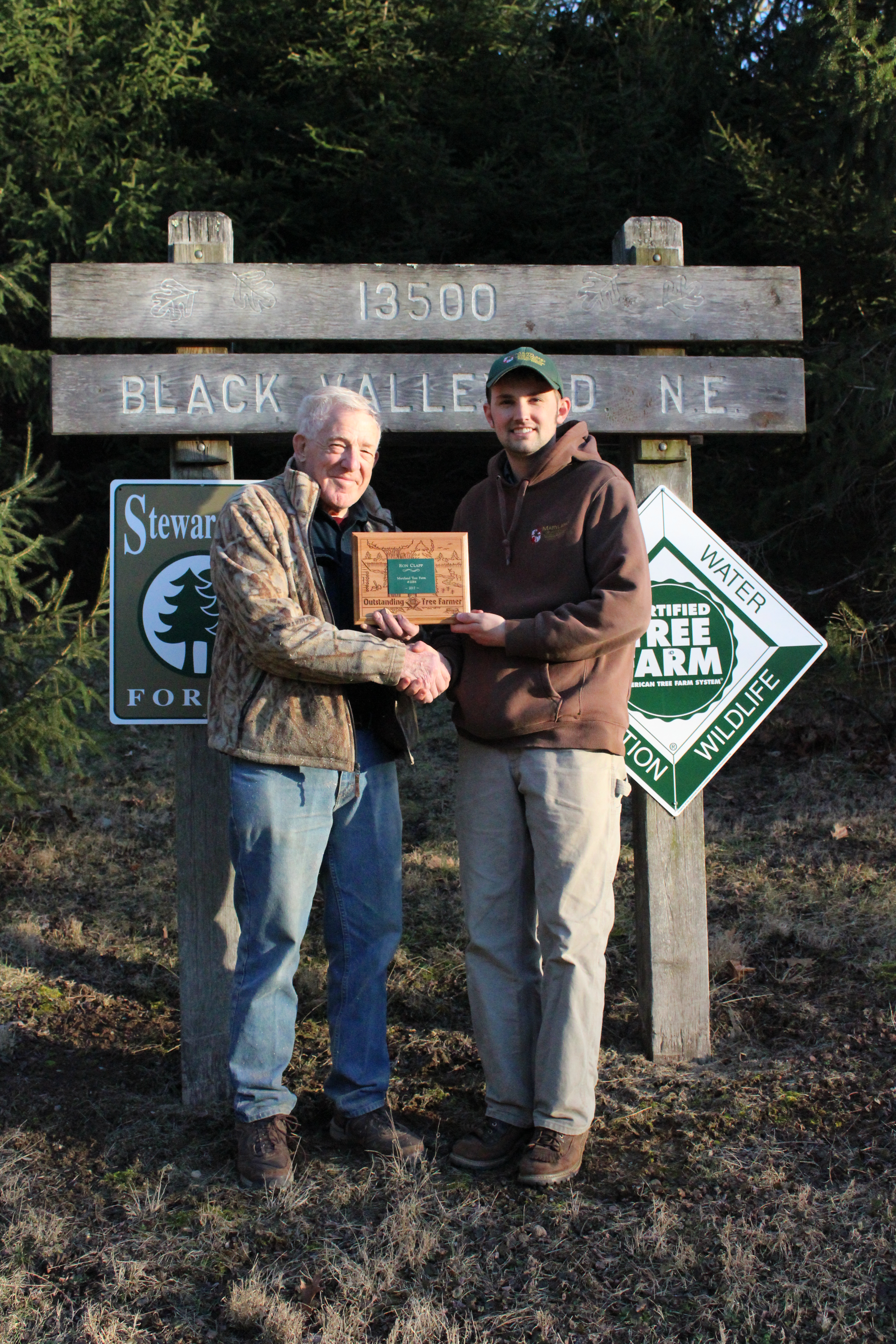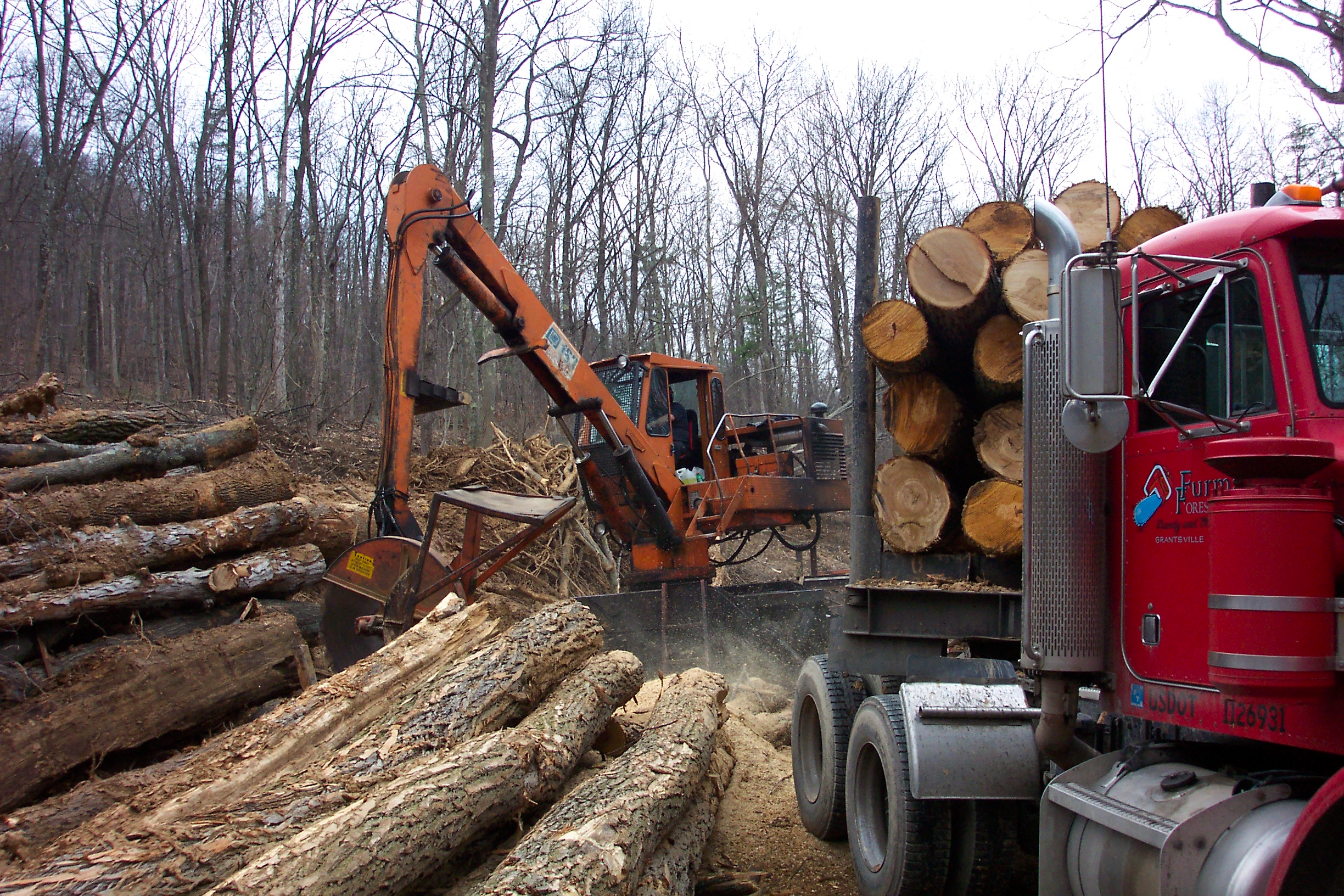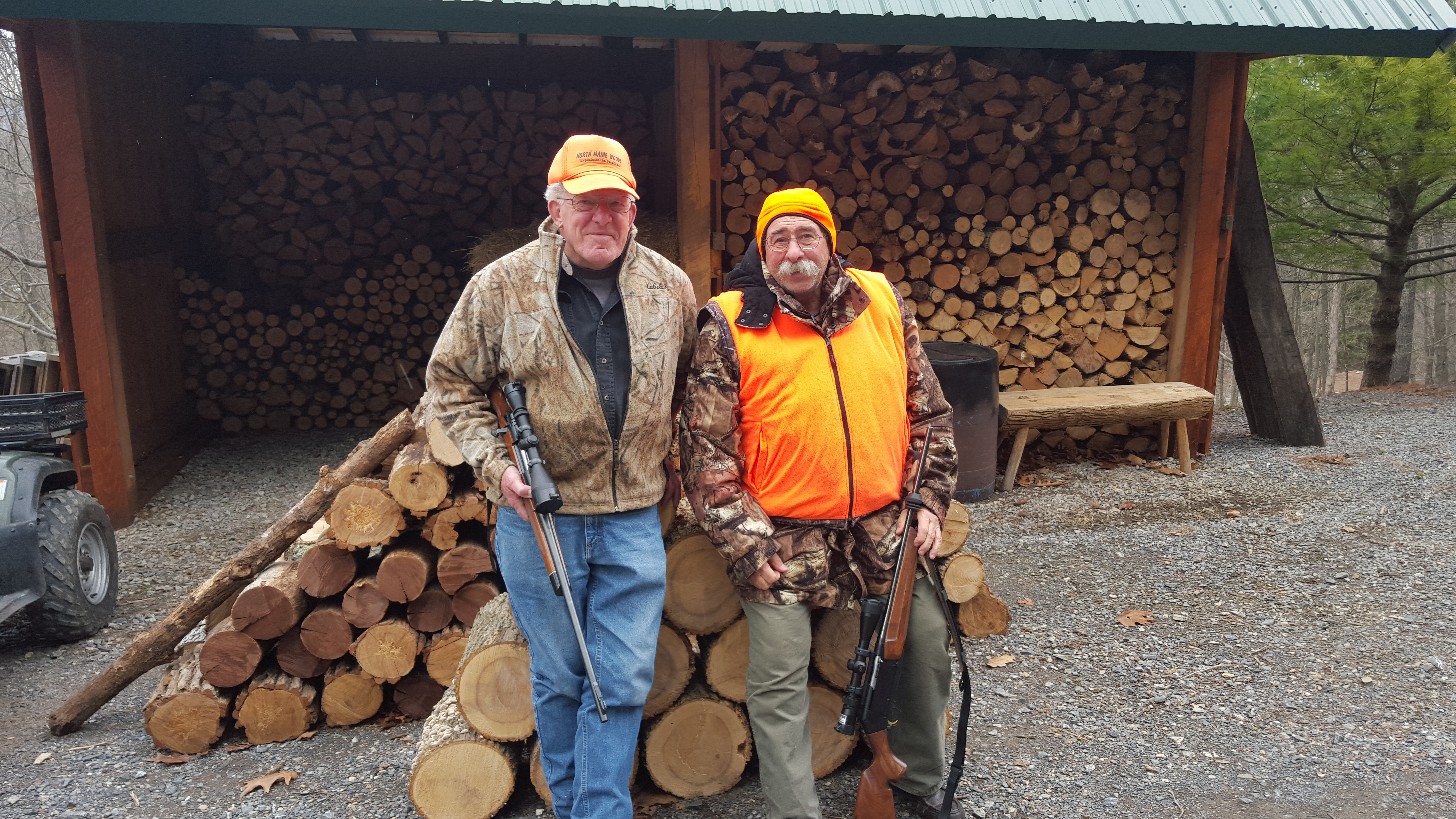Ron Clapp from Maryland
 What Makes Them Oustanding?
What Makes Them Oustanding?
Ron has been actively managing his forest resources since the early 1990s. He consistently seeks advice and recommendations from the Forest Service for various forest management practices on his property. He then carries out these recommendations with enthusiasm and is proud to showcase the work he has accomplished. His management practices include, but arenot limited to: implementing timber harvests (commercial and non-commercial), invasive plant treatment, establishing and maintaining wildlife food plots, tree plantings to benefit water qualityand wildlife, and maintaining woods roads following current Best Management Practices.
Additional activities that Ron participates in include: stream monitoring of local streams through a volunteer group known as Ridge and Valley Streamkeepers, working with Allegany College to allow students to use his property for forestry labs and projects, assisting neighbors build log cabins and other wood related projects, and volunteering with RVS for an annual tree planting in the Town Creek watershed. Ronís Tree Farm has hosted events and tours, including: the Allegany county Forestry Board, middle school students, and Town Creek Steering Committee. Ron is very community oriented and is always willing to lend a hand to anyone in need in the local community. He is well known in the area as a good steward of the land and a friendly neighbor. Ron also has an exceptional passion for conservation of Natural Resources. His Tree Farm is a perfect example of this, as well as his desire to volunteer with various organizations in the field of natural resources.
Tree Farmer Story
Ron purchased his Tree Farm in 1972 as a place to get away and enjoy the great outdoors. At that time little did he know about the hard work and dedication it would take to properly manage this Tree Farm and all of its natural resources. There was no residence on the property at that time, it was only forest land with limited access. Since that time, Ron has built a log cabin, garage, and a wood shed all from local wood resources. He has had a Forest Stewardship plan developed from the Maryland Forest Service, which meets specific objectives. He has implemented various timber harvests, developed forest roads and trails for access, established wildlife openings, and more. These things took a lot of hard work and dedication to accomplish and he is proud of his accomplishments today. Through this process there have been several obstacles and challenges. One of his biggest challenges has been with non-native invasive plants.
Within the last 15 years or so, Ron has been constantly battling with invasive plantspecies, including: ailanthus, mile-a-minute, Japanese stiltgrass, and others. Through this process he has consistently sought after professional advice from the Forest Service. Ron has treated approximately 3 to 5 acres of mile-a-minute vine, 1 to 2 acres of Japanese stiltgrass, and over 1,000 ailanthus trees on 5 to 10 acres. Other challenges Ron has endured include: maintaining woods roads on very steep slope. Ron has been committed to installing and maintaining water breaks, as well as maintaining vegetation on the trails in order to reduce erosion. In one spot, Ron had Japanese stiltgrass growing all over the trail, he treated the stiltgrass and planted a native grass like rye to replace it. This was both beneficial for soil and water quality, but also for wildlife habitat. Ron has used his tree farm for public service and community involvement in several ways. In this way, he has been very proactive in promoting Tree Farm to the local community.
Ron has generously allowed Allegany College forestry students to use his property for various forest related labs and projects. In doing so, he has demonstrated to youth just what it takes to be a successful, active Tree Farmer, which practices exceptional forest management in a sustainable manner. Many of these young individuals will go on to pursue a career in management ofnatural resources, so Ron has a direct impact on these students by being an outstanding Tree Farmer. Ron also has a direct influence on his community and neighboring forest landowners. Ron has specifically helped 3 forest landowners to harvest timber and then utilize the forest products to make wood products.
He also shares recently learned, new ideas, and recommendations about invasive species treatment and wildlife management with these same forest landowners and many others. Any of these folks would gladly call Ron a friend and agreat ambassador for sound forest management. He has built numerous items from wood on his own property, including: his cabin, wood shed, garage, as well as various decorative items. Ron has also worked closely with local wood processing businesses, including: sawmills, a cabinet shop, and a molding mill. He has an excellent relationship with these businesses and has been a significant supporter for more than 20 years. This represents the complete process of managing forest resources in a sustainable manner, while utilizing the available forest resources on a given property. Ron has used his Tree Farm as an example on several occasions. In one example, the Allegany County Forestry Board came out to his property to see how to properly treat and control Ailanthus (Tree of Heaven) using the hack-in-squirt method. Various members wereable to see the benefits (what works and what doesnít work) when Ailanthus trees were treated properly.
Another example of how Ron has opened his Tree Farm up for demonstration, is when he had two teachers and two students from Washington Middle School come out and tour a commercial timber harvest. In this example, students and teachers were interested in seeing the process of a commercial timber harvest. Ron, in conjunction with local foresters was able to educate these individuals on the various steps of a timber harvest on a first hand, visual basis. Ron has also volunteered on the Town Creek Steering Committee for ecosystem management. This committee was created by Dan Hedderick, Project Manager in Allegany County to help guide caring landowners in managing the Town Creek Ecosystem in a sustainable manner. This committee helped to advise a long-range planning guide for ecosystem management in the town creek watershed. Ron was an active voice with the Town Creek Steering Committee.
As previously mentioned, Ron is also an active member with Ridge and Valley Stream Keepers (RVS). He has been active with this local volunteer organization for over 20 years. The mission of RVS is to monitor water quality in eastern Allegany County and to promote forested buffer plantings, in order to improve water quality. Through this time he has monitored various sites and assisted with several buffer plantings, which he always does with enthusiasm, passion, and a cheerful attitude.
In summary, Ron goes above and beyond the average Tree Farmer in order to promote sustainable forest management on every level. He is locally connected with various volunteer organizations and has a direct impact on students, both high school and college. He understands not only how important proper forest management is, but how important it is to pass this knowledge on. He demonstrates this in various ways and whole-heartedly cares about natural resources in his community and region.
Wood
Ron is a carpenter by trade, so wood products have been important to him even before he owned his Tree Farm. He built his log cabin, wood shed, and storage barn all from local wood products. Ron has an exceptional relationship with local wood saw mills, cabinet shop, and a molding mill. He has a personal relationship and has both bought lumber from and supplied lumber to these local businesses. The first commercial timber harvest on Ronís Tree Farm was in the mid 1990s, and was an overstory removal, which removed all trees that were biologically mature. The sale was 67.4 acres and was cut by loggers from Cessnaís Brothers Lumber - a local sawmill. Since that sale he has had one other commercial thinning on approximately 27 acres, which occurredabout 10 years ago. I have included pictures from this timber harvest, where students came outto watch the operation in action. In addition to these timber harvests, Ron has implemented noncommercial thinnings known as crop tree release on his Tree Farm. This is to improve tree growth, mast production, and promote wildlife habitat. Ron uses this wood for firewood, as his only source of heat is from two wood stoves in his cabin. Ron has implemented approximately 10.0 acres of crop tree release thinning on his Tree Farm. This in combination with removal o fdead and dying ash, supply him with enough firewood for the winter. Not only has Ron used local wood products on his Tree Farm, but also with several friends and neighbors. He has helped build a couple different houses in the area, as well as barns and garages. These have been constructed mostly from lumber purchased at local saw mills and wood shops.
his Tree Farm. He built his log cabin, wood shed, and storage barn all from local wood products. Ron has an exceptional relationship with local wood saw mills, cabinet shop, and a molding mill. He has a personal relationship and has both bought lumber from and supplied lumber to these local businesses. The first commercial timber harvest on Ronís Tree Farm was in the mid 1990s, and was an overstory removal, which removed all trees that were biologically mature. The sale was 67.4 acres and was cut by loggers from Cessnaís Brothers Lumber - a local sawmill. Since that sale he has had one other commercial thinning on approximately 27 acres, which occurredabout 10 years ago. I have included pictures from this timber harvest, where students came outto watch the operation in action. In addition to these timber harvests, Ron has implemented noncommercial thinnings known as crop tree release on his Tree Farm. This is to improve tree growth, mast production, and promote wildlife habitat. Ron uses this wood for firewood, as his only source of heat is from two wood stoves in his cabin. Ron has implemented approximately 10.0 acres of crop tree release thinning on his Tree Farm. This in combination with removal o fdead and dying ash, supply him with enough firewood for the winter. Not only has Ron used local wood products on his Tree Farm, but also with several friends and neighbors. He has helped build a couple different houses in the area, as well as barns and garages. These have been constructed mostly from lumber purchased at local saw mills and wood shops.
Water
Ron considers soil and water quality on his own Tree Farm on a regular basis. The majority of Ron's property is on steep slopes, which have various trails and roads. On these steep roads, Ron maintains water breaks, as well as native vegetation on the road in order to minimize soil erosion, which can be detrimental to water quality. Ron has participated in a program with the MD Forest Service, known as Backyard Buffers. This program gives away packets of free seedlings to landowners in order to promote riparian forest buffers. Ron has planted several packets of tree seedlings over the years, as well as other tree plantings across the Tree Farm. Ron has also been a member of Ridge and Valley Streamkeepers (RVS) for over 20 years. This mission of this local volunteer organization is to monitor water quality in eastern Allegany County, Maryland. In addition to sampling various streams on a monthly basis, they also promote forested buffer plantings, and assist with at least one planting each year. Ron has been an active member and a voice for this organization for many years. In recent years, he has recruited several new people and taught them how to properly sample the water. Ron has also assisted friends and neighbors with riparian buffer plantings. One instance of this was included in an article in "Mountain Discoveries", which I have included in the attached files. Ron promotes the importance of water quality not only on his Tree Farm, but across the community as well.
Wildlife Including Threatened and Endangered Species
Wildlife management is one of Ron's main objectives for his Forest Stewardship Plan. I nparticular, Ron manages for white tail deer and turkeys. Ron frequently seeks advice from the MD Forest Service, as well as the MD Wildlife Service for new management techniques. Ro nhas established several wildlife food plots across his Tree Farm, which account for approximately 1.0 acre. In one of these, he planted Sunn Hemp, which is considered to be very beneficial for wildlife. One of Ron's friends and hunting buddies read about Sunn Hemp in an article and he asked Ron if they could try it. Ron was willing to give it a try and it turned out to be a huge success! In addition to food plots, Ron has planted various mast producing trees across his Tree Farm. He has observed various wildlife coming to these trees over the years, including bear, deer, and turkeys. Ron has also implemented various forestry practices as well. Not only has he implemented commercial harvests, which promote diversity and thick regeneration, but also various non-commercial thinnings. In particular, Ron has implemented crop tree release thinnings and created wildlife brush piles with branches. These areas have become attractive to deer and other wildlife because of thick cover for bedding and regeneration for browse. Ron has also been striving to created Ruffed Grouse habitat on his Tree Farm. Ruffed Grouse are very uncommon in this area, and require unique habitat with early succession forest, as well as mature forest nearby. After one of his commercial thinnings, Ron and his fellow hunters noticed that grouse were starting to show up. This was likely a direct result of his active management on the property. Properly managing for wildlife on his Tree Farm is one of the most important things to Ron.
Recreation and Aesthetics Including Special Sites
 Recreation and aesthetics are the main reason why Ron purchased his Tree Farm more than 40 years ago. Having lived in an urban area prior to owning his Tree Farm, he wanted a place to get away and enjoy the natural beauty of the great outdoors. That's exactly what he has with this Tree Farm; his cabin is completely surrounded by the forest, as he has no yard. Every day he lives the natural beauty of a forested landscape and its many benefits. Ron shares his Tree Farm with various friends and family, as he allows hunting on his property. Every year, a group of hunting buddies come up and seek out the elusive white tail deer, bear, and turkey. In addition tofriends, Ronís son Mike comes up during hunting season. Although he thoroughly enjoy shunting, Ron just enjoys riding his UTV across his Tree Farm and spending time in the woods with his friends and family. These people not only hunt on Ronís Tree Farm, but also help with various wildlife management practices throughout the year. Ron's Tree Farm also offers aunique special site that only occurs in certain areas in Allegany County Maryland, sink holes and karst topography. Ron's Tree Farm lies on a ridge that is primarily limestone, which is known to have many sick holes and caverns in the area. Ron's property is no exception, there are various sink holes across his Tree Farm. He is sure to carefully manage in a way to preserve these unique features. Ron's Tree Farm has breath taking vistas of the ridge and valley region of Maryland, from the top of Warrior Mountain. This view showcases natural beauty and aesthetics, especially in the fall months when fall colors are at peak.
Recreation and aesthetics are the main reason why Ron purchased his Tree Farm more than 40 years ago. Having lived in an urban area prior to owning his Tree Farm, he wanted a place to get away and enjoy the natural beauty of the great outdoors. That's exactly what he has with this Tree Farm; his cabin is completely surrounded by the forest, as he has no yard. Every day he lives the natural beauty of a forested landscape and its many benefits. Ron shares his Tree Farm with various friends and family, as he allows hunting on his property. Every year, a group of hunting buddies come up and seek out the elusive white tail deer, bear, and turkey. In addition tofriends, Ronís son Mike comes up during hunting season. Although he thoroughly enjoy shunting, Ron just enjoys riding his UTV across his Tree Farm and spending time in the woods with his friends and family. These people not only hunt on Ronís Tree Farm, but also help with various wildlife management practices throughout the year. Ron's Tree Farm also offers aunique special site that only occurs in certain areas in Allegany County Maryland, sink holes and karst topography. Ron's Tree Farm lies on a ridge that is primarily limestone, which is known to have many sick holes and caverns in the area. Ron's property is no exception, there are various sink holes across his Tree Farm. He is sure to carefully manage in a way to preserve these unique features. Ron's Tree Farm has breath taking vistas of the ridge and valley region of Maryland, from the top of Warrior Mountain. This view showcases natural beauty and aesthetics, especially in the fall months when fall colors are at peak.


